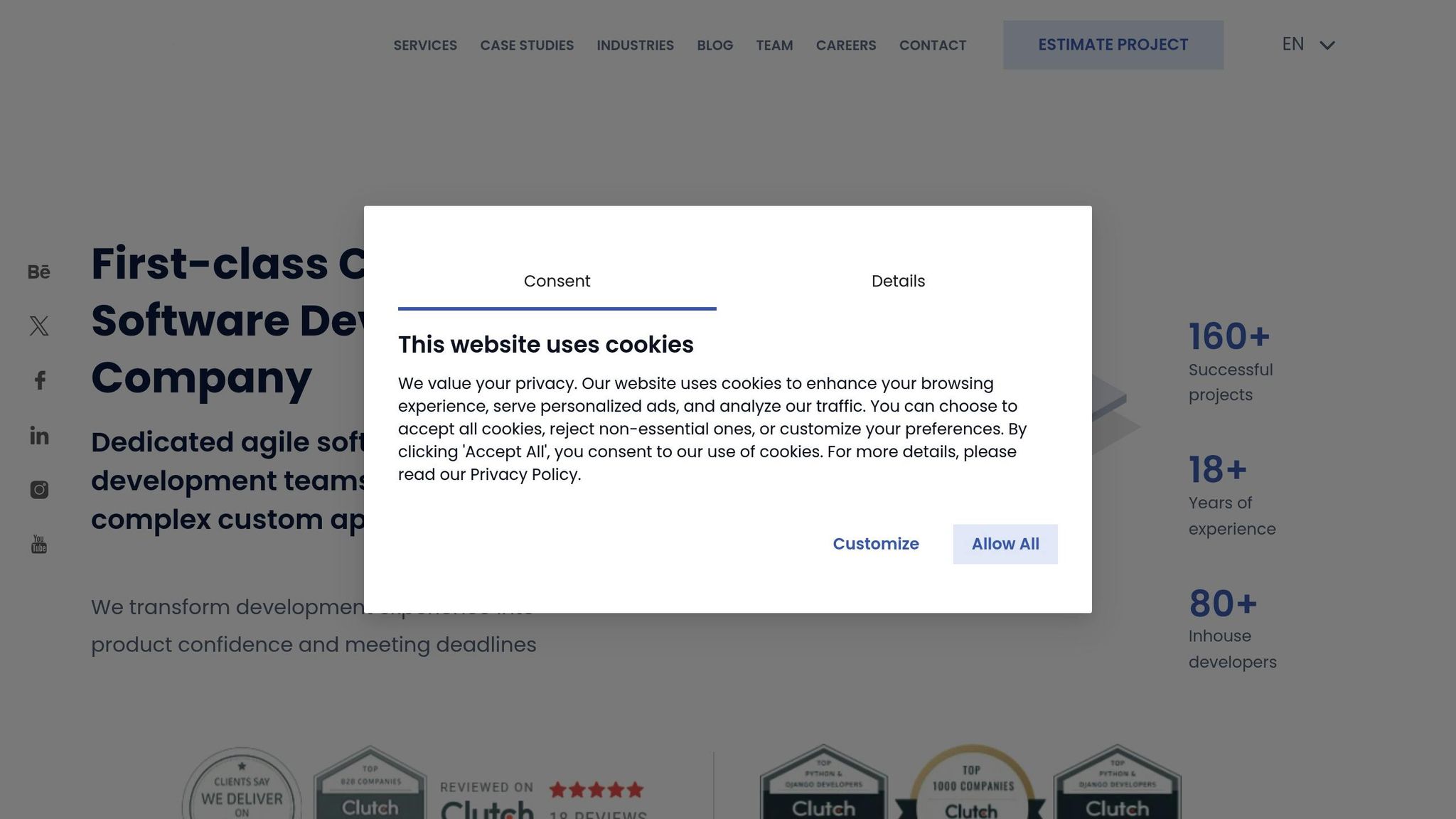When you pick between your own devs or an outside dev team, it hits your cash, how good your item is, and how free your biz can be. Here’s an easy split down:
- In-House Devs: They know your item well and stick around, but they ask for more money. They get between $90,000 and $220,000 a year, plus another 25–35% for extras like health, tax, and stuff like tech and a place to work. Just hiring them might cost $30,000–$50,000 for each one.
- Outside Teams: They’re more bendy and cost less at first. Their charges run from $25–$80 each hour, based on where they are (far or close). Having an outside team helps you set a fixed budget since charges cover boss work, tools, and space, but talking and keeping on top of things can be hard.
Main Points to Look At:
- Cost: Your own team costs more right off the bat, but with outside teams, you know your total costs up front.
- Speed: Outside teams might get your first model out in 4–8 weeks, while your own team may need 3–6 months.
- Risks: Your own team might change often and find it hard to grow. With outside teams, not talking well and relying too much on them can be issues.
Fast Side-by-Side:
| Thing | In-House | From Others |
|---|---|---|
| First Cost | More (pay, perks, gear) | Less (set rates) |
| Change Ease | Not much | A lot |
| Ready Time | 3–6 months | 4–8 weeks |
| Hold On It | Strong | Okay |
| Growth Speed | Slower | Quicker |
Your choice should match your aims, time plan, and money limit. If you need fast MVP build or special skills, hiring out is good. For long work with hard needs, a team inside your firm may be best.
In-house vs Outsourcing Software Development Team For a Startup | Profil Software

Costly Developers vs Outsourced Teams
First, let’s break down what each choice means. The phrases "costly developers" and "outsourced teams" point to two different ways to set up a tech team. Each has its own cost steps, work ways, and team actions that can change how much money your start-up spends.
Costly Developers Made Simple
In the U.S., "costly developers" means full-time, in-house tech pros who get big pay for their skills, city, or special know-how. Being more costly doesn’t always mean they are better.
In big tech cities like San Francisco, New York, or Seattle, pay for top full-stack devs often goes from $150,000 to $220,000 each year, while mid-level devs make $120,000 to $160,000, and new devs with 1-2 years of work get $90,000 to $120,000 yearly.
But pay is just one part of the cost. The full price of bringing a dev in-house also includes:
- Benefits and taxes: These push the salary up by 25–35%, with costs for health care, 401(k) plans, days off, and tax. For a $150,000 salary, this is $37,500–$52,500 each year.
- Tools and space: Gear like laptops, screens, programs, and office spots can set you back $3,000–$5,000 per dev each year, with just the office spot costing $500 to $1,200 each month in pricey places.
- Finding and starting: It can take 15–25% of a dev’s first-year pay to hire them, plus money for talks, checks, and getting them started. This can sum up to $30,000–$50,000 before the dev even starts to help.
Hiring in-house devs means you plan to keep them for a while, often 12–24 months. You also need to offer paths for growth, good pay hikes, and ways to build their skills to keep them happy and staying.
On the other hand, outsourced teams are a way to be more flexible and grow when needed.
Outsourced Teams Made Simple
Outsourced teams are third-party groups that give you full dev teams. You’re not their boss; you’re their client.
Nearshore outsourcing means working with teams in nearby lands with close time zones and cultures. For U.S. startups, this might mean working with devs in Mexico, Canada, or parts of Central and South America. Pay for their time often goes from $40 to $80 per hour, and paying by project may cut costs more.
Offshore outsourcing uses teams in places like India, Ukraine, or the Philippines, where pay is lower, often $25 to $60 per hour. This choice can save a lot of money, but differences in time and talks need extra handling.
A new way, called Engineering-as-a-Service, gives you teams that work like part of your own group, not just hired help. Groups like AlterSquare might ask for a monthly pay of $10,000 to $50,000, based on how big and skilled the team is.
The big win of giving jobs to others is ease. You can change how many people work for you with just 30–60 days’ notice, unlike the long-time need for workers in your own place. Things like pay, benefits, and gear are dealt with by the other group, giving you more time and saving stuff.
There are a few types of deals you can have:
- Pay by the hour: This gives you a lot of room but needs you to watch the project close to keep costs down.
- Set-price tasks: These make costs sure but can cause fights about what the work includes.
- Monthly pay: This gives you a sure team at a known cost each month.
Lots of groups that you can hire also have project leading, checking quality, and tech planning in what they offer, making a full package for making stuff. This cuts out your need to make and look after these skills on your team.
Yet, giving jobs to others does mean you lose some control over daily work and might hit bumps in talking if the team is far away or works differently. Still, big groups normally have clear ways to do things that can make making things smoother and work better than if you do it all inside.
Both ways – keeping it inside or giving it out – bring different costs and risks in how things run. Picking the right one will hinge on what your new business aims to do, its money plan, and how it sees itself growing later.
Full Cost: In-Team vs Hired Out
When looking at the real cost of setting up a team, you need to think about more than just the basic pay. Full ownership costs take in some extra, often unseen costs that can grow fast, hurting new businesses the most. These costs are key in shaping how you map out your product making plans, more so when getting ready for a basic working model (MVP). Let’s dive into the main cost types that make these two differ.
Hidden Costs to Look At
The price of keeping a team inside your company reaches well past the simple salary. Here’s what you should count:
- Base Pay: Pay is only the start. Add to it perks, payroll taxes, insurance, and added money for later and you see the fuller cost.
- Hiring and Starting: Bringing people on isn’t low-cost. With tests and checks to starting steps, these early costs are big. Plus, new folks need time to get fully up to speed, raising costs.
- Tools and Equipment: Think of tech needs, software rights, and top office spots. These can boost what you need at the start.
- Leading Costs: As your group gets bigger, you’ll want more leaders, which means more costs.
- Worker Leaving: When you lose team people, you pay to fill spots and face work slowing down.
For new companies, these hidden costs can strongly change how you hand out money for your MVP.
Outsourcing and All-in Costs
Outsourcing shows a different cost setup. Many side costs – like hiring, starting, gear, and some leading tasks – are all part of the service charge. This method makes budgeting simpler and sets a standard cost, easing planning. Yet, outsourcing has its own rough spots. Talking and working together can get tricky, more so with remote groups. Success often rides on making clear plans, regular meetings, and detailed records to stay on track with your business aims.
Cost Look: In-Team vs Hired Out
Here’s a quick look at how the costs add up:
| Cost Type | In-House Dev | Outsourced Team |
|---|---|---|
| Base Pay | More; it has salary and more costs | Less; one price has all costs |
| Benefits & More Costs | More costs you need to add | Part of the monthly price |
| Tech & Software | Separate costs you need to add | Comes with the service |
| Office Space | Need to plan and pay extra | Not needed (service deals with it) |
| Hiring & Starting | Costs a lot at the start | Simple and rolled into the cost |
| Managing the Team | Costs grow with team size | Managed within the outsourced plan |
| First-Year Total Cost | Much more when you count all | Often less with all in one services |
This table shows how the unseen costs of keeping an in-house team can build up fast. For instance, when making an MVP for a SaaS product, an in-house team needs a lot of money to start – not just in pay, but also in hiring, gear, and leading. On the flip side, hiring out, like with AlterSquare’s MVP program, often gives a less costly way that lets you enter the market faster.
While hiring out might need some changes in how much you control and how well you fit in, its power to cut down full costs makes it a good pick – mostly for startups trying to keep to small budgets while moving fast.
Working Fast and Smart
An hourly pay rate doesn’t tell the whole tale. In terms of getting things done, how fast and how well work is done often matters more than how much each hour costs – especially if you need to get your MVP (Minimum Viable Product) out there fast.
What Makes You Productive?
Many things play a part in how fast and well a team can get things done:
Team Know-How and Focus
Your own developers know your product well. They can make changes fast and fix problems quickly since they know the system fully. Their long-time work helps them manage tough issues well.
On the other hand, teams you hire have lots of experience from different jobs in various fields. For instance, when AlterSquare works on MVPs, they use tried and tested ways. This know-how can help dodge errors that a less seasoned in-house team might run into.
Tools and Making Things Automatic
Your own teams may need time to get needed tools and processes ready, like test systems or ways to get the product out. In contrast, hired teams often come with these setups ready to go, saving lots of time and work – this is a big plus for new companies.
Working Well from Far Away
Since 2020, working from afar has become usual, but not all teams are up to speed. Many in-house teams are still getting better at working together online, whereas hired teams often are ahead in this area, having used methods that suit remote work for a long time.
Switching Contexts
Your own developers may have many tasks, from going to meetings to fixing user issues. This constant switching can break their focus. Hired teams, though, usually just work on developing, which keeps their productivity steady through projects.
These points have a big say in how we see productivity and how fast work gets done.
Comparing Speed and Quality
When checking productivity, two main things stand out: how fast work gets done and how well the work is done. Here’s a look at how your own teams and hired teams compare:
| Metric | In-House Developers | Outsourced Teams |
|---|---|---|
| Sprint Speed | Starts slow but speeds up with known features | Fast at first; may slow down on hard logic |
| Bug Count | Less bugs in known areas; more in new ones | Same bug count with good testing |
| Feature Hardness | Good with linked features | Better for single or basic features |
| Time to First Launch | 3-6 months (hiring and set up too) | 4-8 weeks with skilled teams |
| Passing on Info | Grows over time with in-team know-how | Needs clear notes and hand-offs |
This text shows how each method supports different aims. For new firms wanting to move fast, outsourced groups often lead. While getting and teaching an in-house coder can take months, a skilled outsourced crew can start showing results in days. This fast pace is key when you’re testing a new idea or grabbing a quick chance.
Code Quality Outsourced crews usually count on set checks and tough tests to stay even. In-house crews, with tough times, might miss these steps, leading to uneven results. Yet, once an in-house crew gets fully used to the work, they often reach better long-term speed, due to their full know-how of the product and smooth talks.
Picking the Right Way
The choice between in-house and outsourced making depends on what you want and when you want it. If you need a quick MVP done, an outsourced group with ready flows and skills might be your best pick. But, if you’re eyeing a long plan with tricky mixes, making an in-house crew could give the deep plan you need.
Keep in mind that talks delays – just like unseen costs – can cut into getting things done. Open and ahead talks are key to keep your work on path and keep up the push.
sbb-itb-51b9a02
Hidden Dangers and Tips to Cut Them
When you run a project, it’s not just about cutting costs or moving fast. Hidden dangers can quietly mess things up, boost costs, or bring new problems. Spotting such risks early means you can get ready and dodge big shocks, making sure your project stays right on course.
Top Dangers for Each Method
Risks with In-House Team
A big issue with your own team is when too much know-how sits with just a few folks. If key staff leave, they take critical system info with them, possibly causing big delays. This hits hard in fields where skilled people often switch jobs.
If you pile too much work on your in-house team, they might burn out, which ups the risk of them leaving. When they go, you lose not just their skills but also the deep knowledge they hold.
Adding to your team can be slow. Hiring and teaching newcomers takes time, which might stall your project while chances slip away. Hiring fast under pressure can end with bad team matches, causing more issues later.
Choosing quick work to meet deadlines without good testing can make tech debt pile up. This short-term fix tends to lead to long-term care woes.
Risks with Outsourced Teams
Outsourced groups bring their own troubles. Gaps in talking – due to time zones, language, or different work styles – can slow things down and brew mix-ups.
Relying on an outside team is risky. If they hold your code and setup, shifting to a new group can cost a lot and eat up time. To cut this risk, ensure deals let you own the code and include regular info sharing.
Without direct checks, code quality might drop, which can later cause bugs and extra costs. When you work across different places, you also risk losing control over your ideas. Secure your own work and ideas with careful deals and constant watch.
Weighing these risks against the cost perks of hiring out takes careful thinking. The chart below shows typical risks and ways to fix them.
Chart of Handling Risks: Issues and Fixes
| Risk Type | Main Issue | Main Effect | How to Stop |
|---|---|---|---|
| Knowledge Loss | Top coder leaves with key info | Work delays and high fix costs | Write down steps well and teach all team members |
| Communication Breakdown | Wrong needs cause wrong work | Fixing and money spent wrongly | Have many video talks, give full plans, and check work often |
| Vendor Lock-in | Hired team holds all code and setup | Costly and long changes needed | Keep code rights, pick common tools, and look over work well |
| Quality Drop | Bad code makes fixing hard | New features slow and more bugs found | Use code checks, test often, and set quality points often |
| Scope Creep | Unclear needs add more work | Money lost and late work | Set clear deal terms, have ways to manage new requests, and meet regularly |
| Security Risk | Weak safety steps risk key data | Legal issues, lost trust, and rule problems | Do safety checks, test for weak spots, and use rule lists |
Smart Ways to Cut Down Risks
Once you spot possible risks, you need to set up safety steps.
For teams in your company, dodge info jams by making sure many team members know key systems well. Keep records fresh with tools like Confluence or Notion, and update them often as new bits are put in.
To keep your top workers, offer more than just high pay. Give chances for growth, like money for classes, going to meet-ups, and clear job steps. These extras make your people feel needed and keep them around longer.
For teams you hire, clear talks are key. Have regular meetings, use tools to manage projects, and set special ways for fast chats. Make sure to set quick reply times and steps to fix issues, so all runs smooth.
Check on quality often, too. Regular checks on code, tests that run on their own, and okaying stages can find issues early, saving time and cash.
Measures to Guard Your Deals
Keeping your gains safe starts with solid deals. For hired teams, add parts in the deal for keeping the code yours and needed info sharing. Be clear on what needs to be done and when, to keep all in line.
Link payments to big steps, not just hours worked. This way, you pay for real work done. Adding fines for being late or bad work can guard you more.
For your own teams, think about deals to keep them as well. Offer bonus for staying through big projects and push for full records to lessen risks when people leave.
When to Choose In-House vs Outsourced Teams
Picking the right team, whether in-house or outsourced, isn’t simple. Your choice needs to line up with your startup’s aims, how soon you need things done, and what your needs are. Each way has its plus points, and knowing when to use each can shape a plan that grows with your business.
When to Get In-House Developers
For Key Product Parts
If your product wins by using new tech or tough, smart tools, an in-house team can be best. Having your own set of mind-full developers means key parts work well with your big plan. They can make choices fast and smart.
For Long Work with Many Changes
If your product must keep getting better as users say what they want, an in-house team that knows your code well can work faster and better. They get problems fast and fix them well.
In Rules-Heavy Jobs
Jobs like money care and health need to follow strict rules. Here, in-house developers with deep job know-how help you get through hard rules, cutting down costly slips.
For Deep Links with Old Systems
Tasks that need a strong link to old systems, user lists, or in-job tools get more from the close work that in-house teams give. Being near lets them talk better with other teams, making sure tech fixes fit business goals.
When Growing Fast
As your company gets big fast, you must make choices fast. An in-house team, deep in your game plan, can change fast with no slow-downs that often come when you work with outside groups.
These cases show when having an in-house team helps, mainly for long-term growth and command over key tech.
When to Get Outsourced Teams
While in-house teams are best for control and a long haul, outsourced teams bring change-up and reach to skilled work.
For Quick Tests with Little Money
If you’re trying out a new work idea and need a Minimum Workable Product (MVP) out fast and cheap, picking an outside team works well. They can get an MVP done sooner, helping you check your idea without using up too much.
When Needing Special Minds
Some tasks need hard-to-find know-how like smart learning, crypto-stuff, or top UI/UX craft. Hiring out lets you use these skills for a short time, and costs less than keeping a full-time pro.
For Fast Going Big
When a chance comes, moving fast matters. Outside teams can get ready fast, letting you grab chances quicker than if you had to start a team from zero.
For Less Key Tasks and Keeping Up
Jobs like making control boards, check tools, or mixing with other services fit better with outside teams. This leaves your main team free to work on new stuff that makes your product stand out.
To Try New Tech or Markets
If you’re trying out new tech or going into new areas, hiring out can be a safe way to test. Once you confirm the chance, you can choose to bring those skills inside.
For Old System Changes
Hired teams can quickly fix old systems, letting your own team work on new and big plans.
The trick to do well is to match your making plans with what you need and have now. Many new companies start with hired teams to move fast and spend less, changing to an inside team as they get big and need more say over their main tech. This mixed way can give the room and speed you need to grow well.
Wrap-Up: Picking Wisely
Choosing between getting in-house devs or hiring from outside hinges on what your startup aims for, how soon you need results, and resources on hand. Think about costs, how much work gets done, and the risks. Make sure your pick fits well with the main goals of your business. Both options bring their own ups and downs that could really sway how well your product does.
Key Points
Costs include more than pay. While in-house devs not only get pay but also perks, gear, workspace, and training, outside teams often have fixed charges per project. Yet, hiring outsides might come with extra costs due to poor chat, time differences, or changes to the plan.
How much gets done depends on the job. In-house groups excel when deep know-how and fast updates matter, as they are right in the middle of your work. Outsides, though, fit well for expert tasks, fast startup building, or taking care of side jobs.
It’s key to handle risks right. In-house groups may have trouble keeping people, finding the right skills, or growing. Outsides could bump into issues in talking, keeping up quality, or sharing know-how. The best pick depends on what risks your startup can take care of better.
Where your business is right now counts too. Brand new startups might do well hiring outsiders to quickly shape up a product and try out the market without big costs up front. If your business is growing and finding its edge, it could be smarter to bring key project work inside.
Mixing outside help for side tasks and in-house folks for big new ideas can be a good play too. This mix lets you be flexible, manage costs well, and grow wisely as your business changes.
Next Steps?
Look well at your timeline, budget, and what your product needs. Think of things like rules, how complex joining things together is, and your plans for big growth.
If you feel hiring out is best, look hard for a group that feels like part of your team, not just hired help. Choose firms that get your business goals, chat well, and have good past work with startups.
For those thinking about hiring out, AlterSquare is worth a look. They have a strong service range, doing everything from startup building to top-notch AI work, helping startups grow well while keeping hold of control and quality.
The choice you make can push your company up or cost you lots, in both time and stuff. Take enough time to weigh your options – how well your product does hangs on this.
FAQs
What should startups consider when choosing between hiring in-house developers and outsourcing development teams?
When weighing the choice between hiring in-house developers or working with outsourced teams, startups should consider three important aspects:
- Control and communication: Building an in-house team allows for stronger alignment with your company’s values and provides more direct oversight. But this comes at a price – fixed costs like salaries, benefits, and office-related expenses can add up quickly.
- Cost and scalability: Outsourcing is often a budget-friendly option, especially for startups operating with limited funds or dealing with unpredictable project demands. It also opens the door to a global talent pool, making it easier to scale operations as needed.
- Project complexity and goals: For long-term or highly intricate projects, having an in-house team ensures consistency and seamless integration. On the flip side, outsourcing works well for shorter-term initiatives or when agility and speed are essential.
By carefully examining these factors alongside your startup’s goals, budget, and available resources, you can make a more informed decision about which option aligns best with your business needs.
How can startups address communication and quality challenges when outsourcing development work?
Startups can tackle the common hurdles of communication and quality in outsourcing by laying down clear expectations and leveraging collaboration tools that support seamless, real-time interactions. By defining project goals, timelines, and deliverables right from the start, you can reduce the risk of misunderstandings and ensure everyone stays on track.
To ensure high-quality outcomes, it’s crucial to have a well-structured plan in place. This should include detailed specifications, architecture diagrams, and measurable benchmarks to guide the process. Regular progress reviews, milestone testing, and constructive feedback help identify and resolve issues early on. Additionally, fostering a culture that prioritizes quality assurance and building strong, trust-based relationships with your outsourced team can pave the way for long-term success.
What are the long-term effects of hiring in-house developers compared to outsourcing for a startup’s growth and adaptability?
Hiring in-house developers can accelerate a startup’s growth by providing more control, quicker decision-making, and a deeper connection to the product. This setup often results in stronger alignment with the company’s objectives and encourages fresh ideas. That said, it’s not without its hurdles – higher expenses, challenges in retaining skilled developers, and potential limits when scaling the team can be significant concerns.
On the flip side, outsourcing offers flexibility and helps manage costs, making it easier to adjust team size based on current needs. While this approach might mean giving up some direct control, it enables startups to respond swiftly to market shifts and concentrate on their core business goals. Deciding between the two ultimately hinges on your startup’s specific objectives, financial resources, and overall growth plan.
Related Blog Posts
- Staff Augmentation vs. In-House Hiring: What Growth-Stage Startups Need to Know
- Offshore, Nearshore, or Onshore: Which Outsourcing Model Is Right for Your Startup?
- The Hidden Costs of DIY vs. Outsourced Development – and How to Avoid Them
- When Should Startups Stop Outsourcing and Build an In-House Team?









Leave a Reply